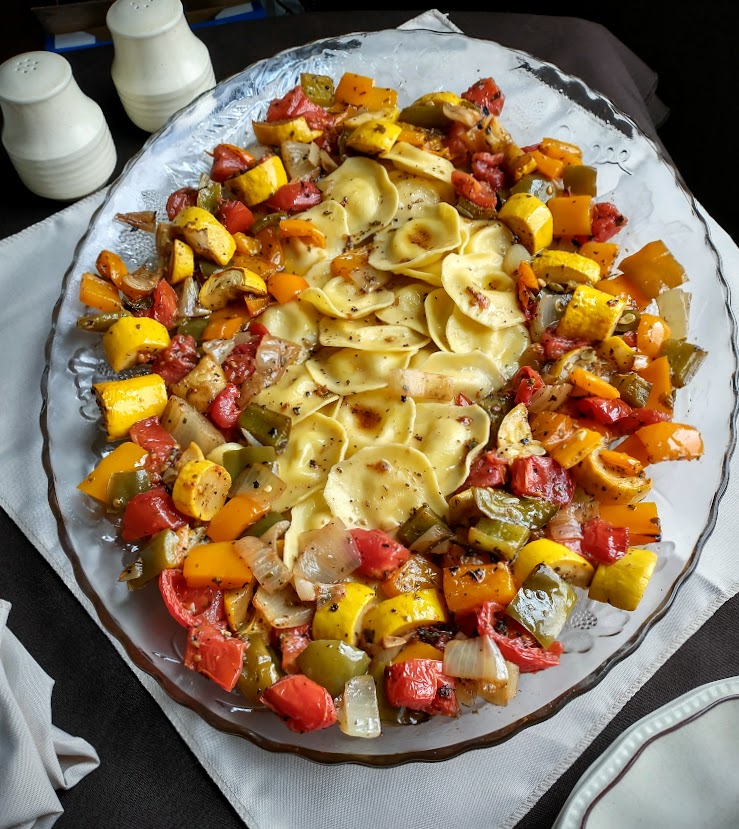Without losing all the cheese
Cooking cheese filled pasta or any filled pasta for that matter takes some special treatment or they will break and leak.
Right up front, if you don’t care if you lose the cheese filling from a few of your tortellini or ravioli, just follow the directions on the package and treat it like any other pasta; boil it and drain it in a colander. No harm done. They are delicious. Personally, I hate having the leaked cheese filling floating around in the pot as it boils, and my frugal nature isn’t pleased that a number of my pasta pockets no longer have cheese.
Over the years I have stumbled my way to success in bringing whole pasta pockets to the dinner table by making simple changes to my usual pasta routine. I am offing my humble tips to those of you who may be interested.
Be gentle with them right from the start
Fresh and frozen cheese filled pastas are delicate, right from the time you get them out of the package. It is very common to have pieces of filled pasta stuck to each other when they come out of the bag. Don’t try to separate them. When you try to peel them apart, you can easily tear the pasta dough. Now you have an open rip. Scene one in the saga of how to help cheese leak out.
As the dough gets softer in the boiling water, they will fall apart on their own.
Give them plenty of room
Get a large pot to boil the pasta in so these delicate morsels have room to float around. Put plenty of water in the pot.
Don’t add oil to the water.
Boil gently
Bring the water to a slow boil, not a big rolling boil.
A full boil is fine for dried pastas, but not filled pastas. A full vigorous boil is a major cause of leaky cheese😊. If the water gets to a rolling boil while you are heating it up, turn the heat down and let the boil settle down.
When you have a slow, gentle, steamy boil, drop the pasta into the water with as little disturbance as possible. When the cold pasta is added to the pot the water is going to cool down. Stay at the stove and monitor the boil. Adjust the burner heat accordingly to bring the water to, and maintain, the boil you want.
I don’t start timing my boil until the slow boil has returned. Follow the directions on the package for cooking time. It usually only takes 3 to 5 minutes if fresh, maybe a little more for frozen.
You do not defrost filled pasta before you cook it.

Here are my raviolis at a slow, steamy boil. Maybe you can see that there is some small bubbling around the sides of the pot.
From time to time while they are cooking I gently move them around to encourage uniform cooking. A wooden spoon is a good tool for this. It doesn’t have sharp edges to pierce the pasta. As you can see, the raviolis are not tumbling around in the pot like pasta at a full boil does.

That brings us here. After boiling for the recommended time, the pasta is done.
Rather than dump the water out into a colander, get a large, long handled slotted spoon of some sort and spoon the pasta out. Holding the pasta in the spoon, let any excess water drip back into the pot. The wire spoon in the picture is one of my mother’s “handy dandies”. It is perfect for this job.
Don’t let them stick together
You aren’t out of the woods when you have lifted the pasta from the water. These pasta pockets will stick together if they start laying on top of each other while they cool.

This is my heavy duty, glass oval serving dish. It’s a good sized plate and that makes it great for this job.
It’s not easy to see, but I put some olive oil on the plate before I started spooning the pasta on. The oil will help prevent sticking. Distribute the pasta pockets apart from each other on the plate as you spoon them out. It also helps to gently move them around in the oil a bit.
If you have a whole single layer and you need to start layering the pasta, add some more oil to the top of the first layer. I add oil on the top either way and with clean hands move all the raviolis around in the oil.
Whatever sauce I am serving with this pasta, will have olive oil in it, so there is no conflict in flavor. If your sauce has another oil, use that oil in this process.
When the raviolis start to cool, you may see little indentations in the middle like seen in one of the raviolis in the picture above. It’s just the air settling down. It isn’t an indication that you have been the victim of leaky cheese syndrome.
Serve on individual plates or in a serving dish, like we have in the following picture of ROASTED VEGETABLES WITH PASTA.


